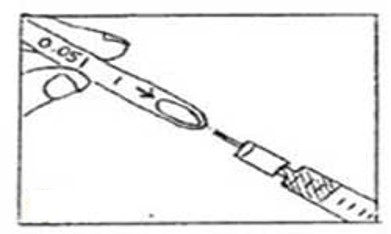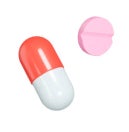Uses
How should I take or use Desmopressin Intranasal Solution?
| Directions to use: | Pictures |
1. Pull plastic tag on neck of via.
|  |
| 2. Break security seal and remove plastic cap. |  |
| 3. Twist off small knurled seal from the dropper. Use the same seal reversed to prevent subsequent leakage, especially if the vial is not stored upright. |  |
| 4. There are several methods to measure out the required dose. For dose that can be measured accurately with the plastic Rhinal tubea) Take the calibrated part of the plastic tube in one hand and place the fingers of the other hand around the cylindrical part of the dropper. b) Insert the tube marked with an arrow into the dropper. Squeeze the dropper until the solution has reached the desired mark. c) Withdraw the dropper quickly downwards. Continue to squeeze the dropper while withdrawing. |  |
For dose <0.025mL or dose that cannot be measured accurately using the plastic Rhinal tube b) Transfer dose into the plastic rhinal tube for administration. |  |
For older children and adults: Hold the tube with the fingers approximately ¾ (three-quarters) inch from the end and insert it into a nostril until the tips of the fingers reach the nostril. For neonates, infants and young children: Gently insert the plastic Rhinal tube into a nostril, just far enough so that the solution does not run out. The infant/young child should be held firmly and securely. |  |
5. Put the other end of the tube into the mouth. Hold breath, tilt back the head & then blow with a short strong puff through the tube so that the solution reaches into the nasal cavity. Alternatively, another person can help to blow the liquid into the nasal cavity. Through this procedure, medicine is limited to the nasal cavity and does not pass down into the throat. |  |
For neonates, infants or young children who are unable to self-administer dose, a syringe or a dropper can be used to aid administration Tilt the baby’s head back slightly. Draw some air into the 1mL tuberculin syringe and re-insert the syringe into the other end of the tube. Slowly push the plunger of the syringe so that the air inside the syringe would push the solution into the nasal cavity. |  |
| 6. After use, reseal dropper tip and close the bottle with the plastic cap. Wash the tube with water and shake thoroughly, till no more water is left. The tube can then be used for the next application. |  |
Handling
How should I store Desmopressin Intranasal Solution?
- Keep away from children
- Keep in a cool, dry place, away from direct sunlight
For more information
What else should I know about Desmopressin Intranasal Solution?
0.01 mg/mL (extemporaneous prep) | 0.1 mg/mL (2.5mL) | |
| Storage | Fridge (2-8 degree celsius) | Fridge (2-8 degree celsius) |
| Expiry after opening | 4 weeks | 2 months* |
* When travelling, unopened bottles will maintain stability for 4 weeks (1 month) if stored at room temperature (max 25°C).
Disclaimers
If you take more than the recommended dose, please seek medical advice immediately. The information provided on this page does not replace information from your healthcare professional. Please consult your healthcare professional for more information.
This article is jointly developed by members of the National Medication Information workgroup. The workgroup consists of cluster partners (National Healthcare Group, National University Health System, and SingHealth), community pharmacies (Guardian, Unity, and Watsons), and the Pharmaceutical Society of Singapore. The content does not reflect drug availability and supply information in pharmacies and healthcare institutions. You are advised to check with the respective institutions for such information.
Contributed by
Last Updated on July 2020

Need More Medicine?
Use Medicine Order Service on HealthBuddy.

Medicines Reminder
Get reminders and chart progress on HealthBuddy.




















